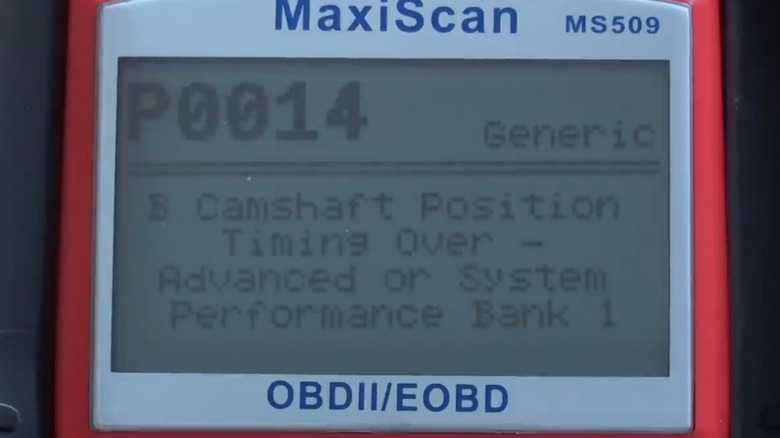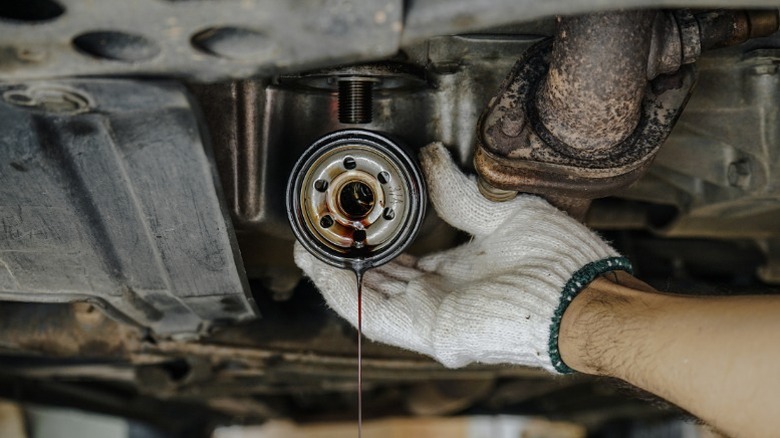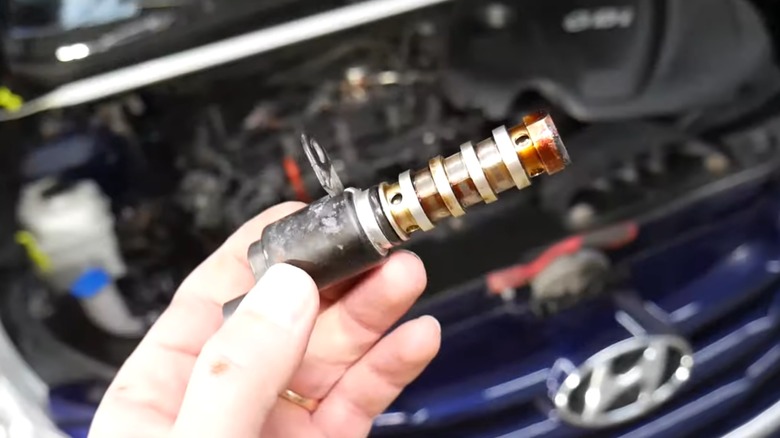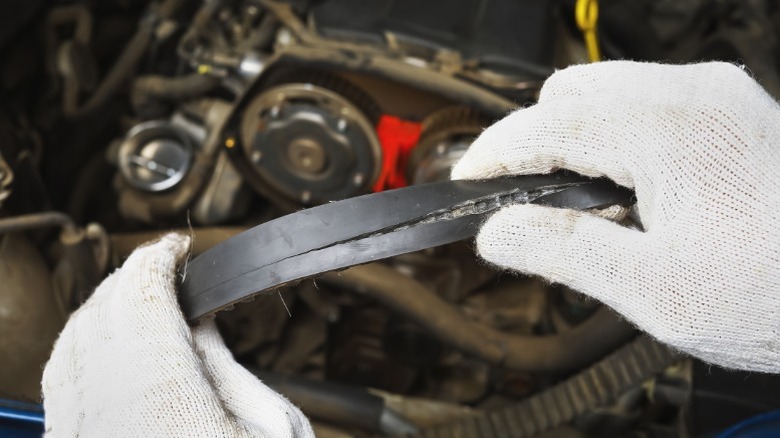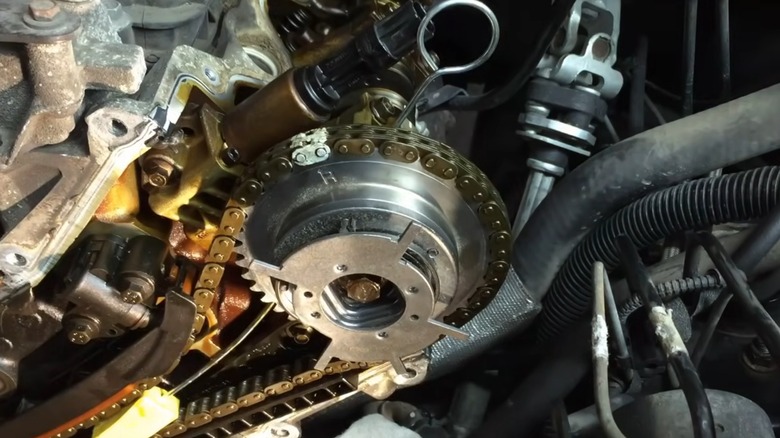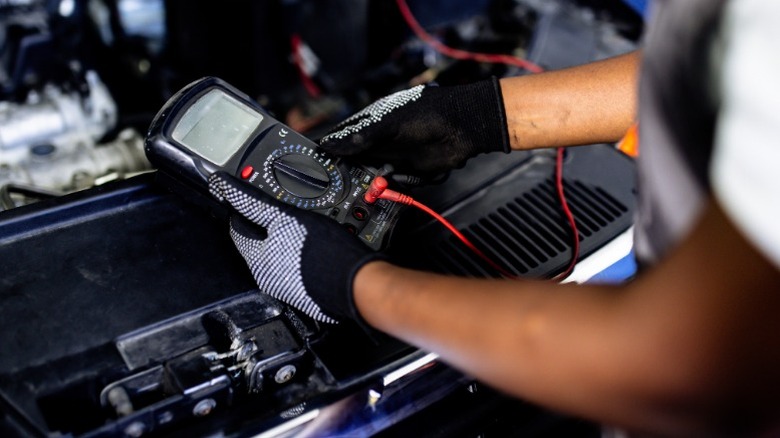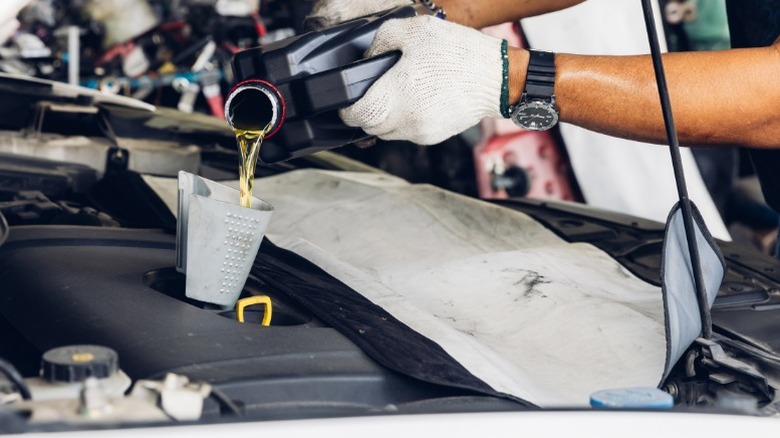What Does The P0014 Code Mean, And Can You Fix It Yourself?
Modern cars have various dashboard warning lights designed to alert you if something's wrong with your vehicle and help diagnose automotive problems. One of the most infamous automotive warning lights is the check engine light (CEL), which can appear if the onboard diagnostic (OBD) system detects a malfunction or error. The OBD system works with the car's computer and a vast network of electronic sensors to monitor the vehicle's performance. If it detects a problem, it can trigger a diagnostic trouble code (DTC), which you can then read and diagnose using an OBDII scan tool.
One common DTC that you may encounter if you drive a modern vehicle with variable valve timing (VVT) is P0014. Depending on your scan tool, the code may appear along with the words "Camshaft Position B Timing Over-Advanced or System Performance Bank 1." It means that there's a problem with the exhaust camshaft timing in Bank 1, which, in V-style engines, refers to the side of the engine that houses cylinder number 1 — if you have a four-cylinder DOHC engine, the P0014 code refers to the exhaust camshaft. When we say that something is wrong with the camshaft timing, it means that the camshaft is opening and closing valves (in this case, exhaust valves) at an irregular or incorrect speed. In engines with VVT, that speed can change based on driving conditions, and the P0014 code can appear if the camshaft's actual speed and computer-projected speed don't match up.
It's pretty complex, and the camshaft timing can be off for various reasons. Fortunately, as a former professional mechanic, I can break it down for you. We'll cover the most common causes of a P0014 code, the potential fixes, and whether it's something you can repair yourself.
You may have low or dirty engine oil
One of the most common causes of a P0014 DTC is bad engine oil. That may translate to a low oil level, using the incorrect oil, or extremely dirty oil polluted by contaminants. You probably already know that oil is an essential component for your engine and its smooth performance, and its primary responsibility is to lubricate internal parts and help with heat dissipation. However, for cars with VVT technology, oil also performs another key duty: it helps actuate the camshaft phasers, allowing the system to modify engine timing based on current driving conditions.
In cars with this type of technology, an oil control or VVT solenoid is responsible for applying oil pressure to the camshaft phasers. In these systems, the engine oil functions like a hydraulic fluid, creating the pressure necessary to speed up or slow down the camshaft timing based on data collected by the computer and current driving conditions. However, if the oil level drops too low, becomes contaminated by dirt and debris, or is too thick or thin for the engine, the solenoid may be unable to perform its job correctly. When this occurs, your engine performance may drop, and you may notice a check engine light on your dash. Keep in mind that engine oil problems can cause a range of issues for your car. It's vital that you monitor the level regularly, use the correct type, and never skip an oil change — following those steps is essential for your vehicle and can go a long way toward extending the life of your engine.
Your oil control solenoid may be failing
Bad engine oil is a common reason why your car's OBD system may trigger the P0014 code. However, it's not the only potential culprit. We mentioned that cars with VVT technology rely on oil control or VVT solenoids to help actuate camshaft phasers and alter the timing. These solenoids work closely with the car's computer system to apply oil pressure to the camshaft phasers. When the system determines that the camshaft timing needs to be advanced, the solenoids apply pressure to the phasers, causing them to spin at a different rate. If the system determines that the camshaft timing needs to slow down, the solenoids can stop applying pressure or apply that oil pressure in a different direction, retarding or stopping the phaser's movement. The solenoids have small openings through which oil is forced, creating the pressure used to actuate the phasers. However, contaminated oil can clog up these holes, causing the entire VVT system to stop working correctly and potentially triggering the P0014 DTC.
While bad oil can cause these solenoids to stop working, if you don't address the issue quickly enough, the solenoids can fail altogether and require replacement. It happens because even small amounts of debris and contaminants can clog up the solenoids. Sometimes, you can get away with cleaning the solenoid and replacing the oil. However, if the solenoid is sufficiently degraded or extremely clogged by debris, you'll probably have to replace it.
Your car may have worn-out timing parts
A lot of different parts work together to maintain proper engine timing. Each of these components has a critical responsibility, and it's vital that they each function smoothly and correctly to avoid various problems. One of the issues that you may experience if your car's timing parts are worn out or failing is the appearance of a P0014 code. However, before we explain why that is, it may be helpful to briefly go over how the timing system works.
You probably know that internal combustion engines rely on a series of small explosions to create power. Those explosions cause the crankshaft to spin, and the crankshaft transfers that rotational energy to the camshaft(s) via a timing belt or chain. The camshaft(s) control the opening and closing of the air intake and exhaust valves, and it's vital that the camshaft and crankshaft are in sync for the entire cycle to function properly. Normal vehicles without VVT technology have a fixed camshaft speed that remains constant at all times — in these vehicles, the camshaft spins at half the speed of the crankshaft. However, cars with VVT can modify the camshaft timing to increase performance, reduce emissions, and improve fuel economy.
If anything goes wrong with one of the car's timing components — like the timing chain, the camshaft itself, belt tensioners, etc. — the system won't run properly. For vehicles with VVT, this can lead to the appearance of a P0014 code, and you may experience problems like an irregular idle, engine misfires, a drop in power, and more.
You may need to replace a camshaft phaser
We've mentioned camshaft phasers a couple of times already when discussing how VVT systems work, but we haven't covered them yet as a potential reason why your car's OBD system can trigger the P0014 code. Camshaft phasers, sometimes known as camshaft actuators, can fail on their own. In fact, these components are a common failure point on some Ford models, an issue that the manufacturer is attempting to address through a program that extends the warranties of affected vehicles. That said, any vehicle with VVT can experience camshaft phaser failure due to manufacturer defects or wear and tear.
If your car has VVT and one or more of its camshaft phasers fail, you may notice that your engine performance drops, hear a strange rattling noise coming from the engine bay, and see a check engine light on your dash — specifically if you use a scan tool to pull the codes, you may see either P0014, P0011 or P0024. The "Position B" part of the P0014 code typically indicates a problem with the camshaft that controls the exhaust valves. That means that if your car throws the P0014 code and no other DTCs are present, you may be able to narrow down the source of the problem. Keep in mind that the lack of additional codes isn't a sure sign that the other phasers aren't also bad, and it absolutely won't hurt to replace all of the phasers at once if the engine is already open. Bad phasers also aren't the only problem that can trigger the P0014 code, so you'll probably want a professional inspection to confirm that they're bad before spending the money on a replacement.
There may be an electrical or computer problem
If none of the issues described above are to blame for your P0014 code, you may have an electrical problem. Remember that the OBD system works closely with the car's computer system and a vast network of electronic sensors to read and analyze data and trigger a fault code if it detects a problem. If a sensor fails, the computer system experiences a malfunction, or another part of the electrical system begins sending inaccurate data, the OBD system may trigger the P0014 code. This is less likely to be the reason for the code's appearance than the mechanical problems covered above. However, it's still a potential culprit due to the fact that the electrical system and sensors connect all of these parts together.
The problem is that electrical issues can be tricky to diagnose, and your mechanic will most likely want to rule out any mechanical problems before moving on to the electrical system. If a professional repair technician determines that your engine oil, VVT solenoid, engine timing, and camshaft phasers are all in good shape, they'll most likely begin testing the electrical system. This may be a lengthy and drawn-out process, as the mechanic will have to test various components. Automotive electrical problems can be extremely complex, and if it turns out that an electrical malfunction is responsible for your P0014 code, you may want to consider visiting a mechanic who specializes in electrical work.
How do you fix a P0014 code, and can you do it yourself?
As you've probably noticed by this point, a P0014 code can be the result of various problems with your car. That means that there are multiple fixes that can be the solution to this particular DTC. Some of these fixes are simple and inexpensive, while others are more complex. If you're wondering if it's possible to perform a DIY repair to address your P0014 code, you'll probably want to take it on a case-by-case basis.
If your P0014 code is the result of poor-quality engine oil or too little oil in the system, the solution may be as simple as replacing the oil. Oil changes are one of the best DIY auto jobs for beginners, and this is definitely a fix you can try yourself before moving on to more advanced techniques. Likewise, replacing the VVT or oil control solenoid is also relatively easy. It's more advanced than an oil change, but most novices should be able to tackle the task with the right know-how.
If your P0014 code is caused by a timing problem, a bad camshaft phaser, or an electrical issue, the fixes are usually more complex. Timing an engine properly is a very technical job best reserved for pros and experienced home mechanics. The same applies to replacing a camshaft phaser, and you may even need special tools to get the job done right. Automotive electrical problems can also be challenging to diagnose and repair and usually require in-depth knowledge of the electrical system. If your P0014 code is the result of any of these last three issues, you're probably better off visiting a professional mechanic unless you're extremely confident in your car repair abilities and have access to a range of specialty tools.
